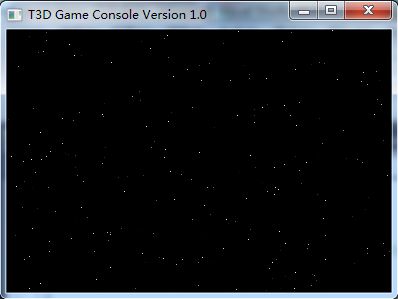《Windows游戏编程大师技巧》 T3D游戏控制台程序实例及第一部分总结
现在我们要创建一个Windows外壳程序,将单调的Windows运行细节隐藏,
Win32/DirectX编程就变得类似于32位DOS的编程过程。在构建好的代码结构下,
我们只需关心Game_*几个有关游戏逻辑的方法就行了。
1.Game_Init()
Game_Init()在WinMain()中的主事件循环之前被调用,并且仅调用一次。它用于初始化游戏
所需的各种资源,如获得资源设备描述表DC。
2.Game_Main()
Game_Main()在主事件循环中每次处理Windows消息之后被调用一次,应当在Game_Main()中
处理所有的图像渲染、声音、人工智能等内容。需要注意的是你必须仅绘制一帧画面然后就
返回。
3.Game_Shutdown()
Game_Shutdown()在主事件循环退出后被调用,清除游戏中被分配的所有资源。
#define WIN32_LEAN_AND_MEAN
#include <windows.h>
#include <windowsx.h>
// DEFINE AND GLOBALS //////////////////////////////////////////////////
#define WINDOW_CLASS_NAME "WINCLASS1"
#define KEYDOWN(vk_code) ((GetAsyncKeyState(vk_code) & 0x8000) ? 1 : 0)
#define KEYUP(vk_code) ((GetAsyncKeyState(vk_code) & 0x8000) ? 0 : 1)
HWND main_window_handle = NULL;
HINSTANCE hinstance_app = NULL;
char buffer[80];
// Function prototype //////////////////////////////////////////////////
LRESULT CALLBACK WindowProc(HWND, UINT, WPARAM, LPARAM);
int Game_Init(void *parms = NULL, int num_parms = 0);
int Game_Main(void *parms = NULL, int num_parms = 0);
int Game_Shutdown(void *parms = NULL, int num_parms = 0);
// WINMAIN ////////////////////////////////////////
int WINAPI WinMain(HINSTANCE hinstance,
HINSTANCE hprevinstance,
LPSTR lpcmdline,
int ncmdshow)
{
WNDCLASSEX winclass;
HWND hwnd;
MSG msg;
// 1. Fill in the window class structure
winclass.cbSize = sizeof(WNDCLASSEX);
winclass.style = CS_DBLCLKS | CS_OWNDC |
CS_HREDRAW | CS_VREDRAW;
winclass.lpfnWndProc = WindowProc;
winclass.cbClsExtra = 0;
winclass.cbWndExtra = 0;
winclass.hInstance = hinstance;
winclass.hIcon = LoadIcon(NULL, IDI_APPLICATION);
winclass.hCursor = LoadCursor(NULL, IDC_ARROW);
winclass.hbrBackground = (HBRUSH) GetStockObject(BLACK_BRUSH);
winclass.lpszMenuName = NULL;
winclass.lpszClassName = WINDOW_CLASS_NAME;
winclass.hIconSm = LoadIcon(NULL, IDI_APPLICATION);
// 2. Register the window class
if (!RegisterClassEx(&winclass))
return (0);
// 3. Create window
if (!(hwnd = CreateWindowEx(NULL,
WINDOW_CLASS_NAME,
"T3D Game Console Version 1.0",
WS_OVERLAPPEDWINDOW | WS_VISIBLE,
0, 0,
400, 300,
NULL,
NULL,
hinstance,
NULL)))
return (0);
// Save global handle
main_window_handle = hwnd;
hinstance_app = hinstance;
// Initialize game here
Game_Init();
while (TRUE)
{
// Retrieve message
if (PeekMessage(&msg, NULL, 0, 0, PM_REMOVE))
{
if (msg.message == WM_QUIT)
break;
TranslateMessage(&msg);
DispatchMessage(&msg);
}
// Main game processing goes here
Game_Main();
}
// Closedown game here
Game_Shutdown();
return msg.wParam;
}
///////////////////////////////////////////////////////
LRESULT CALLBACK WindowProc(HWND hwnd,
UINT msg,
WPARAM wparam,
LPARAM lparam)
{
PAINTSTRUCT ps;
HDC hdc;
switch(msg)
{
case WM_CREATE:
return (0);
case WM_PAINT:
hdc = BeginPaint(hwnd, &ps);
EndPaint(hwnd, &ps);
return (0);
case WM_DESTROY:
PostQuitMessage(0);
return (0);
default:
break;
}
return (DefWindowProc(hwnd, msg, wparam, lparam));
}
///////////////////////////////////////////////////////
int Game_Init(void *parms, int num_parms)
{
return (1);
}
///////////////////////////////////////////////////////
int Game_Main(void *parms, int num_parms)
{
DWORD start_time = GetTickCount();
// Lock time to 30 fps (1s / 30 = 33ms)
while ((GetTickCount() - start_time) < 33);
if (KEYDOWN(VK_ESCAPE))
SendMessage(main_window_handle, WM_CLOSE, 0, 0);
return (1);
}
////////////////////////////////////////////////////////
int Game_Shutdown(void *parms, int num_parms)
{
return (1);
}
下面是一个流星的具体实例,我们在Game_Init()随机初始化256个小星星。之后
每一帧绘制时,首先擦除掉星星位置上的点,之后将星星向屏幕右侧移动并检测
是否到达屏幕边界,最后在新位置上绘制星星。这样就可以进入下一轮的主事件
循环了。
///////////////////////////////////////////////////////
#define NUM_STARS 256
#define WINDOW_WIDTH 400
#define WINDOW_HEIGHT 300
typedef struct STAR_TYP {
int x, y;
int vel;
COLORREF col;
} STAR, *STAR_PTR;
HDC global_dc = NULL;
STAR stars[NUM_STARS];
void Erase_Stars(void);
void Draw_Stars(void);
void Move_Stars(void);
void Init_Stars(void);
///////////////////////////////////////////////////////
int Game_Init(void *parms, int num_parms)
{
global_dc = GetDC(main_window_handle);
Init_Stars();
return (1);
}
///////////////////////////////////////////////////////
int Game_Main(void *parms, int num_parms)
{
DWORD start_time = GetTickCount();
Erase_Stars();
Move_Stars();
Draw_Stars();
// Lock time to 30 fps (1s / 30 = 33ms)
while ((GetTickCount() - start_time) < 33);
if (KEYDOWN(VK_ESCAPE))
SendMessage(main_window_handle, WM_CLOSE, 0, 0);
return (1);
}
////////////////////////////////////////////////////////
int Game_Shutdown(void *parms, int num_parms)
{
ReleaseDC(main_window_handle, global_dc);
return (1);
}
////////////////////////////////////////////////////////
void Init_Stars(void)
{
for (int index = 0; index < NUM_STARS; index++)
{
stars[index].x = rand() % WINDOW_WIDTH;
stars[index].y = rand() % WINDOW_HEIGHT;
// random velocity 1-16
stars[index].vel = 1 + rand() % 16;
int intensity = 15 * (17 - stars[index].vel);
stars[index].col = RGB(intensity, intensity, intensity);
}
}
void Erase_Stars(void)
{
for (int index = 0; index < NUM_STARS; index++)
SetPixel(global_dc, stars[index].x, stars[index].y, RGB(0, 0, 0));
}
void Draw_Stars(void)
{
for (int index = 0; index < NUM_STARS; index++)
SetPixel(global_dc, stars[index].x, stars[index].y, stars[index].col);
}
void Move_Stars(void)
{
for (int index = 0; index < NUM_STARS; index++)
{
stars[index].x += stars[index].vel;
if (stars[index].x >= WINDOW_WIDTH)
stars[index].x -= WINDOW_WIDTH;
}
}
运行起来就是这个样子了。
这是一个使用GDI绘图的不错的小程序,该程序演示了擦除、移动、绘制动画的循环。
第一部分总结
在第2章我们通过一个简单的Windows程序学习了创建一个最简单Windows窗体的步骤:
创建Windows类,注册它,然后创建窗体,编写事件处理函数,最后编写主事件循环
从事件队列获取并分发消息到事件处理函数。并且我们还学会了使用PeekMessage()
而不是阻塞的GetMessage()编写实时的事件循环。
第3章我们学会了如何创建图标、光标、字符串等等各种资源,并在程序中引用它们。
同时我们还学习了GDI基础知识,获得DC句柄,调用TextOut输出文字。以及重要的
窗口、键盘、鼠标事件处理。
第4章我们学习了GDI高级部分绘制各种图形,定时器,常用的按钮等小控件。至此我们
已经掌握了足够的Windows编程知识来应对游戏编程,下面是总结的知识列表,留作日后
复习使用:
1.Windows程序构建步骤:WNDCLASS类、注册、创建窗体、事件处理函数、主事件循环。
2.用PeekMessage()编写实时的事件循环
3.使用图标、光标、字符串等资源,并了解VS自动产生的.RC文件和资源索引文件中有什么。
4.处理常见窗口、键盘、鼠标消息,如WM_CLOSE,WM_SIZE,获得按键,WM_MOUSE*。
5.用GDI绘制文本、点线及各种图形。
6.通过检查系统时钟来控制程序刷新的帧频。
7.使用简单的小控件,如按钮、文本框等等。
接下来我们将进入DirectX的神奇世界!

